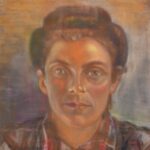
Šleivytė Veronika
Veronika Šleivytė (December 6, 1906 in Antašava, Vabalninkas rural municipality – April 21, 1998 in Kaunas, buried in Antašava cemetery) – Lithuanian artist, painter, graphic artist, photographer. Born into a landless peasant family of a blacksmith with many children, in the town of Antašava. Life was not easy for the large Šleivy family. When Veronika was four years old, her father Jonas Šleivys moved the hut from the town of Antašava to the village of Viktariškės.
Since childhood, she served farmers and dreamed of becoming an artist or a drawing teacher. She graduated from elementary school and, although the family did not have money and her father objected, she began studying at the Kupiškis gymnasium. In 1923, she graduated from four classes of the Kupiškis progymnasium, and in the same year, together with the peasants of the village of Kadāry (Papilios rural municipality, Biržai county), she organized a school, as well as courses for adults. Since the school was not supported by the government, she worked simply for food – the parents of the children fed her in turn (the future artist was only 17 at the time). She worked as a teacher here until 1924.
Driven by great stubbornness, in 1924-1934 she studied at the Kaunas Art School and graduated, acquiring the specialty of an artist-graphic artist and teacher. During that time and later (1927-1940) she worked as a draftsman for the Ministry of Agriculture (in Kaunas), because she had to support herself. In this way, her health deteriorated and she underwent a long treatment. In 1933, she participated in the first exhibition of the Lithuanian Amateur Photographers’ Union in Kaunas.
After graduating from her studies, in 1934-1938 she worked as a drawing teacher at the Catholic Girls’ Crafts School of the Society of the Child Jesus. She was pardoned for bringing the poverty of orphaned students and the injustices they suffered to the public. At that time, she worked at the Women’s Welfare Committee’s craft school. When she escaped the hustle and bustle of the city, she returned to her native village of Viktariškės and the nearby town of Antašava, where not only older members of the community but also curious children were very welcome. She loved to sing and listen to folk songs.
Since 1937, she participated in exhibitions organized by Lithuanian women artists and was an active participant in amateur photography competitions. In 1938-1940, she was the chairwoman of the Lithuanian Women Artists’ Association, which she founded herself. Fulfilling her old dream of traveling the world and learning the secrets of art, in 1939 she visited art galleries in Italy, Germany, Switzerland, and Poland, and became interested in paintings and sculptures. This helped her to better understand the subtleties of human anatomy, which she soon applied to her graphic works.
After the Soviet Union occupied Lithuania, from 1940 she was appointed director of the same “Society of the Child Jesus” craft school and worked there until 1946 (this school changed names: 1940-1941 Kaunas 5th Craft School; 1941-1943 Kaunas 1st State Craft School; 1944-1946 11th State Craft School).
During World War II, the German security institutions became interested in the artist’s personality and past activities. Šleivytė was interrogated, exiled to Kelmė, from where she was to be taken to work in Germany. From there she managed to escape to Kazlų Rūda, where she lived in hiding.
In 1946, she gave up her job and devoted herself to her work. Not receiving any funds, she struggled for some time, supported by relatives living in the village of Viktariškės. During that time, she continued to create and organize her works. As her financial situation improved, she visited museums in Moscow, Leningrad, Kiev, Tallinn, and Riga, where she continued to gain experience.
In 1960, she became a member of the Lithuanian Artists’ Union. In 1984, she was awarded the title of Honorary Citizen of Kupiškis District. Šleivytė was invited to Kupiškis District art and sports festivals and meetings. In 1985, the artist was awarded the title of Honorary Collective Farmer, and in 1986, the title of Honorary Cultural Worker of the Lithuanian SSR.


